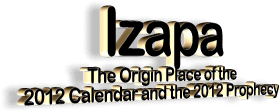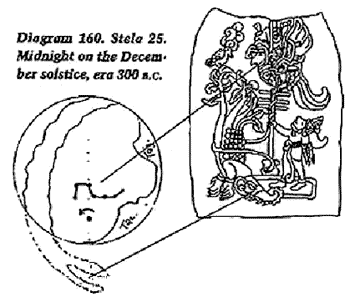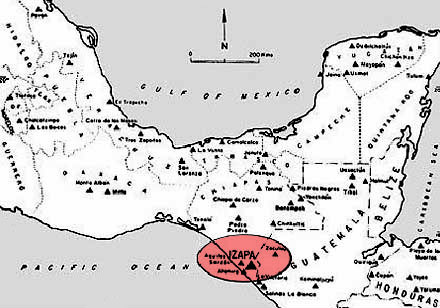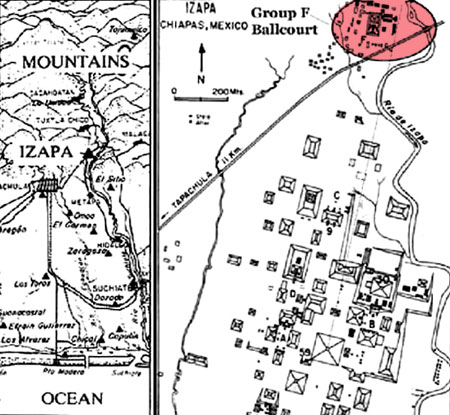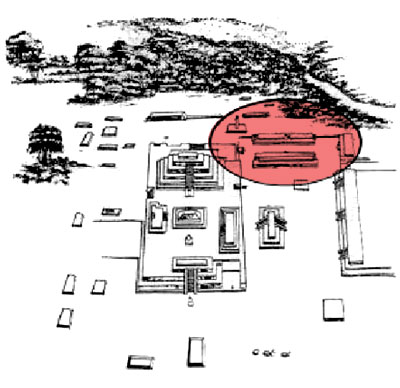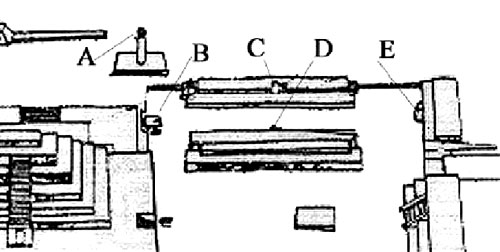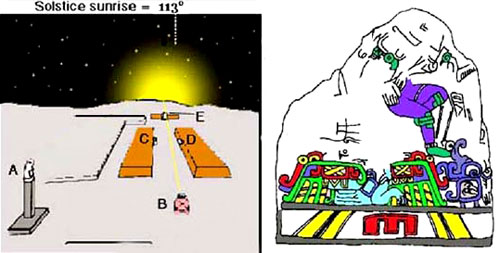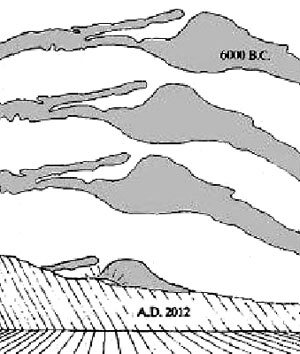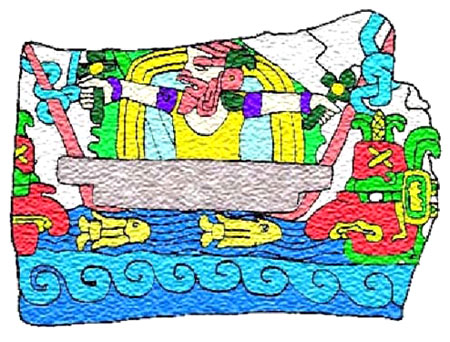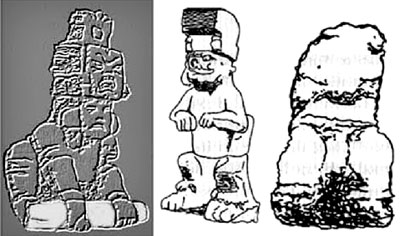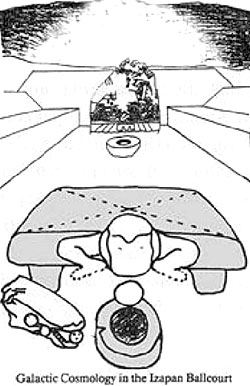|
by John Major Jenkins 2001
from
Alignment2012 Website
Izapan Cosmos
Since
these publications I have felt that Izapan iconography and astronomy
needed more attention, and perhaps supportive illustrations and
diagrams would be helpful to illustrate what we find. In this brief
recapitulation, I will focus on the monuments of Group F, for they
clearly suggest something profound and unrecognized about the Izapan
awareness of astronomy.
Stela 25: The Big Dipper vs. The Milky Way Stela 25 also contains a recognizable Popol Vuh episode, in which Hunahpu’s arm is torn off by Seven Macaw. Since Seven Macaw is identified with the Big Dipper of the polar region, I suggested (1996, 1998) that the “fall” of Seven Macaw involved the demise of an old cosmological system centered upon the polar region. The shamanistic concern with knowing where the center of the sky is located is central to understanding this “cosmological shift.”
The shift, after Seven Macaw was done away with, was to an opposite orientation, as revealed in the diagram above. The dialectic sets the head of the alligator in opposition to Seven Macaw. This “alligator-head” is the location of another cosmological “center of the sky”—it is the location of the center of our Milky Way galaxy. (Note: I am omitting arguments and citations that can be found exhaustively documented in my book Maya Cosmogenesis 2012).
Generally, this monument—as well as many others from Izapa; e.g., Stela 11— indicate an interest in the Milky Way, the dark-rift in the Milky Way (the mouth is the dark-rift), and the Big Dipper.
Izapa's location I’m skipping over many related issues now to move right into the monuments of Group F. My basic idea is that the content of the monuments cannot be fully understood unless we take into account the site’s orientation, local topography, and horizon astronomy.
These factors will be particularly significant for understanding the Group F monuments. First, let’s zoom into Izapa by leaps. Above we see Izapa’s location in southern Mesoamerica.
Next we zoom into Izapa more closely and see that the site is
located between two extremes of nature: mountains to the north and
ocean to the south (left, above). Next, we see the site plan. The
site is oriented some 21° east of true north, which is the sight
line to the peak of Tacana volcano. Also significant, the
perpendicular to this main axis is sighted on the December solstice
horizon. Many monuments (e.g., Stela 11 in Group B) face this
horizon.
A close-up view of the monument at position A will not be illustrated; it portrays a crouching figure on top of a pillar. Despite it's broken condition, archeologists believe it originally faced Tacana volcano to the north. The monuments at position B include Throne 2, a ring-and-ball, and a serpent head with open mouth that was originally a ballcourt marker stone. We will illustrate these shortly.
First let us look at the stela located at position E, on the east end of the ballcourt. If you sat on Throne 2 at the west end of the ballcourt, you would look out over this stela, toward the December solstice horizon.
Stela 60, portrayed here (above right), is the one at position E in the diagram (above left). Although eroded, it is clear that it shows a victorious ballplayer, probably one of the hero twins, standing over a demised Seven Macaw bird deity. This indicates to the viewer two things: the former god, now defeated, and the new god, newly “victorious” or newly “born.”
This scene relates to the Creation myth wherein the hero twins must defeat the vain, false ruler of the previous World Age, Seven Macaw, before their father, One Hunahpu, can be reborn. A lengthy examination of early Mesoamerican calendrics is omitted here, which demonstrate that One Hunahpu—as First Father—was probably associated with the December solstice sun at Izapa. The ballcourt scenario just reviewed confirms that separate argument. (Note: this is a pre-Classic identification.)
And, of course, it needn’t be emphasized—because we can see it in
the diagram above—that the December solstice sun rises over the stela depicting the demised Seven Macaw. This basically says: the
polar god is dead, the solar god is born. However, the solar god’s
rebirth is inextricably involved in its future alignment with the
Milky Way. More on this follows.
Here we see the Milky Way converging with the position of the dawning December solstice sun in a process caused by the precession of the equinoxes. This is a very significant fact: the horizon which we are examining is where a precession-caused convergence between the Milky Way and the December solstice sun has been occurring for thousands of years.
Fact: The solstice solar god and the Milky Way align in the years around AD 2012.
Astronomically speaking, the solstice meridian will align with the galactic plane. Is it a only a coincidence that the designers of the Group F monument arrangements were interested in the horizon along which this convergence occurs? Perhaps. But let’s look now at the two monuments found at locations C and D. These locations are midway along the ballcourt, half-way between Stela 60 and the Throne 2 monuments.
On the north side of the ballcourt, at position C, we find a solar lord sitting in the middle of a canoe with his arms outstretched (see diagram above). The canoe represents both the ballcourt and the Milky Way, toward which the ballcourt is oriented. The outstretched arms indicate a period-ending “measuring of time” event. Since the contextual orientation of the ballcourt is to the December solstice, which itself is a period ending, we might presume that the solar lord is the December solstice lord. (Also supported by the First Father/One Hunahpu = December solstice sun evidence alluded to earlier.)
This stela thus seems to portray the December solstice sun sitting in the middle of the Milky Way “canoe.” It is extremely interesting that the part of the Milky Way that rises over the solstice horizon to the southeast is the nuclear bulge of the Milky Way—the part of the Milky Way that contains the Galactic Center.
(Note: I’ve argued extensively that the nuclear bulge and the
Galactic Center can be noticed with naked eye observation; anyone
can confirm this by looking at the Milky Way on a dark night. Radio
telescopes are not required.)
My main thesis is
that the creators of the Long Count calendar intended the 2012 date
to indicate this alignment of the December solstice sun with the
Milky Way’s center. In the Creation myth, this astronomical
convergence was encoded as the rebirth of One Hunahpu. The earliest
Long Count monuments are dated to Izapa’s heyday (first-century BC).
There are Cycle 7 Long Count monuments at nearby Abaj Takalik and
one at El Baul (long side arguments omitted).
The Olmec sky-lifter on the far left holds a bar that has been
interpreted as the Milky Way. The lifting of the Milky Way has been
interpreted as a Creation event, or perhaps it just indicates that
the sky moves or shifts. The image suggests a deity who shifts the
galactic frame of the sky. (My interpretation here is perhaps close
to a guess, and this ambiguity shouldn’t interfere with the very
clear assemblage of evidence already looked at.)
The main feature here (diagram below) is the throne, which has a head birthing from between two splayed legs —this is an iconographic motif called the hocker position, indicating birthing. [Long related aside omitted that discusses throne-sitting shamans as lords, birthers, ballplayers, and conjurers.]
The birth canal between the legs of the throne figure is analogous to the dark-rift in the Milky Way, a prominent feature along the Milky Way that can be seen in a previous diagram. This “black cleft” feature is called by the modern Quiché Maya the xibalba be (the Road to the Underworld).
As translator Dennis Tedlock has shown, it plays a key role in the Popol Vuh, being also referred to as the Black Road. Generally, as an underworld portal, it is related to the complex of motifs assigned to the jaguar’s mouth, serpent mouths, caves, cenotes, a woman’s birth canal, temple doorways, and so on. A significant equation in this mythic complex is the “dark-rift as birth canal,” for it is through the birth canal of the Milky Way that the solstice sun will be reborn in the years around 2012.
Here, the head is the sun, and the splayed legs frame the birth canal that is the dark-rift in the Milky Way. Below this head is a ball and ring, which refers to the symbolism of the ballgame. [Long argument on the cosmic symbolism of the Maya ballgame omitted, which shows how the gameball is the December solstice sun and the goalring is the dark-rift in the Milky Way.]
Finally, the upside-down serpent
head on the left side of the diagram above: These ballcourt markers
usually had a solar lord (or "ahau" face) in their mouths; this one
doesn’t but it appears broken off. Again, this is the same
symbolism: sun in serpent mouth is equivalent to the other symbols,
all of which indicate, in three different ways, the convergence
occurring over the distant horizon.
But there is nothing here—excepting the better diagrams —that isn’t contained in my book Maya Cosmogenesis 2012 (1998) or my monograph Izapan Cosmos (1996).
One thing is interesting to consider: Given the integrative continuity of my interpretation, based upon a complicated set of interweaving monuments, sculptures, calendrics, and alignments, is it likely that Group F does not have anything to do with the precessional convergence of Milky Way and solstice sun?
|
